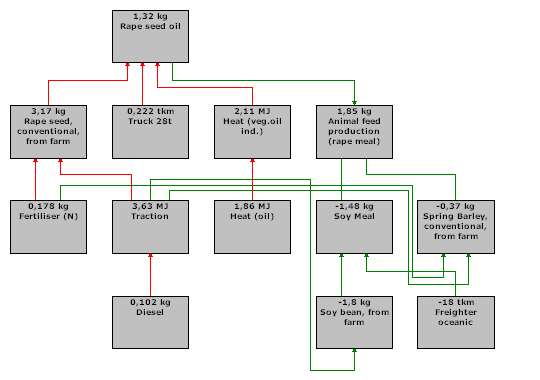Vegetable oil (Vegetabilsk olie)
Rapeseed oil and soy oil are produced by crushing rapeseed respectively soy beans.
The main processes influenced by rapeseed oil demand is shown in the figure below.
|
Node cut-off: 2.0% |
| Figure 1: Market based product chain diagram for rapeseed oil covering the most important processes in terms of contribution to global warming. Boxes refer to production processes. Names of grey boxes refer to the main product of the processes. Red arrows represent material or energy transfer between two processes; green arrows represent saved material or energy transfer as a result of displacements; green lines represent displacements and red lines represent avoided displacemements. Further details can be found in the LCA model. |
Rapeseed cake is co-produced with rapeseed oil in rapeseed crushing process. Rapeseed cake is used in animal feed. It has been assumed (Landbrugets rådgivningscenter, 2000) that rapeseed cake displace a mixture of soy cake (80%) and spring barley (20%). Soy oil generated as a co-product during soy crushing is assumed to displace rapeseed oil.
The extend of soy oil
production is determined by the market demand for soy cake for livestock
feed production and soy oil is in excess in the market. Hence, a demand for
soy oil does not influence the soy oil production but rather the products
that it substitutes. It is assumed that soy oil displaces rape seed oil and
the environmental impacts associated with soy and rape seed oil are equal.
See Weidema (1999) and Weidema (2003).
The potential environmental impacts associated with rapeseed and soy oil demand are shown in the table below. All data are provided per kg of oil.
| Impact category |
Unit |
Ex crushing factory |
Ex retail |
||
|
Conventional |
Organic |
Conventional |
Organic |
||
|
Global warming |
g CO2-eq. |
3510 |
|
3630 |
|
|
Acidification |
g SO2-eq. |
31 |
31 | ||
| Nutrient enrichment | g NO3-eq. | 438 | 439 | ||
| Smog formation | g ethene eq. | 2.0 | 2.1 | ||
| Land use | m2 year | 4.5 | 4.5 | ||
| Location in database: Material/Food from industry/From other industries/ and Material/F ood from sumpermarket/others |
References
Landbrugets rådgivningscenter (2000). Tal fra Fodermiddeltabellen, Raport nr. 91. In Danish.
Weidema BP (1999). System expansions to handle co-products of renewable materials. Presentation Summaries of the 7th LCA Case Studies Symposium SETAC-Europe, 1999. Pp. 45-48. pdf.
Weidema B (2003). Market information in life cycle assessments. Technical report, Danish Environmental Protection Agency (Environmental Project no. 863).
